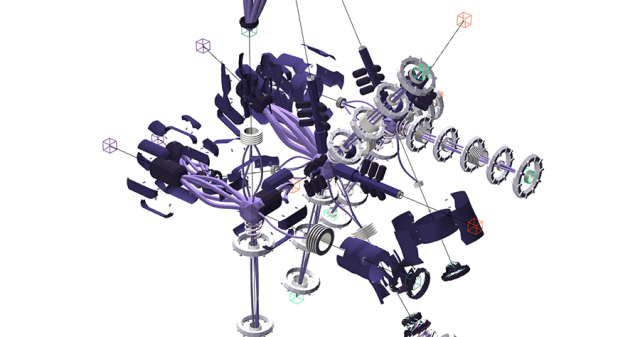Generative Machines
Created by Michael Chang, Generative Machines creates procedural machines blow out diagrams that self assemble. It is an impressive piece of work for me because the machines always look incredibly intricate and technical. The smooth animations which interact with the mouse movements or animate through a set of views are well done. All of the pieces fall into each other and assemble. It is however noticable that the pieces used are only meant to look technical, as they don’t make sense for real machines. This is especially true of the springy-looking bands. I would have liked to see this project done with a wider variety of parts based on existing machinery. This evokes a certain sense of irony in that it generates machines which are meant to look mechanic whereas any normal blow out drawing with similar looks would be describing a machine built to serve a purpose with some utilitarian purpose. This reminds me of background gadgets in SciFi themed media. Designers make objects which look “futury” that could possibly serve a purpose, but viewers have no idea what they may be, they just accept it as part of the aesthetic. This project is similar in that it makes modern looking gadgets which look like they might have a purpose, but clearly do not.
To view it in a browser, see it here Generative Machines
Supernova
Supernova is an iPad app created by Glenn Marshall in 2010. I was particularly interested in it because I couldn’t figure out how he made the misty galaxy effect. I would like to say that he is using a stock alpha particle and drawing it with an additive blend mode to the scene, but I couldn’t figure out the shape of the particle, leaving me to revert to just staring at the imagery created by the app. The colors and shapes are similar to pictures from the Hubble telescope, but the animation is something different. It is smooth and creates a mesmerizing pattern.
EDIT: After staring a while longer I believe that the scene may have been created based on zooming, rotating, moving, colorizing, and overlaying several source images from the Hubble telescope over each other. Along with this some solid white particles may have been used to create a diverse set of differently moving stars. This would explains why such an advanced simulation was capable on an iPad five years ago. It also explains why none of the space dust flowed or changed shape. Nonetheless, it is a good looking project accomplished in an interesting way.
